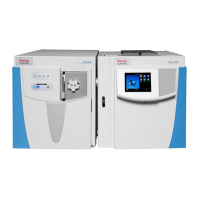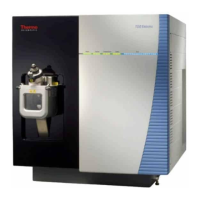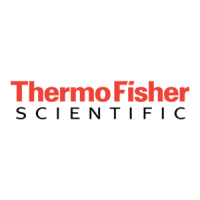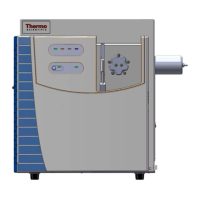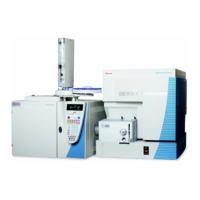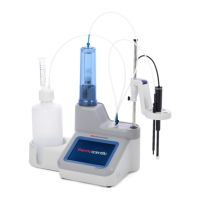2
Functional Description
Mass Spectrometer
34 TSQ Series Hardware Manual Thermo Scientific
The offset voltage applied to Q2 (which contains the collision cell) is responsible for the
collision energy. The collision energy is the difference in potential between the ion source
(where parent ions are formed) and Q2 (where they collide with collision gas). As the offset
voltage on Q2 increases, the TKE of the parent ions also increases. As a result, increases in the
Q2 offset voltage increase the energy of ion/Ar collisions. The collision energy is generally set
to one value for an entire scan and can be set from 0 to ±200 V.
Before obtaining any mass spectra, the TSQ mass spectrometer tunes Q1 in the Q1MS scan
mode (Q2 and Q3 rf voltage only), and tunes Q3 in the Q3MS scan mode (Q1 and Q2 rf
voltage only). During tuning, the TSQ mass spectrometer determines the optimum
quadrupole offset voltage for Q1 and for Q3.
Mass Analyzer Lenses
The TSQ system mass analyzer has three lens sets. See Figure 26 on page 30. Those between
Q1 and Q2 are designated L21, L22, L23; those between Q2 and Q3 are designated L31,
L32, L33; and the lens between Q3 and the ion detection system is designated as L4 (or the
exit lens). All of the lenses have circular holes in their centers through which the ion beam
passes.
The lens assemblies also retain the three rod assemblies to ensure accurate and automatic axial
alignment of the rod assemblies.
The L2x lens set (between Q1 and Q2) and the L3x lens set (between Q2 and Q3) serve these
functions:
• To minimize the amount of collision gas that enters the mass analyzers (Q1 and Q3) from
the collision cell (Q2). (For high-mass transmission, it is important to maintain a low
pressure in the mass analyzers.)
• To retain the collision gas. Lenses L23 and L31 form two of the walls of the collision cell,
so they tend to hold the collision gas in the collision cell. The collision gas escapes,
however, through the same lens holes through which the ion beam passes.
• To prevent gas from entering the mass analyzers. Lenses L22 and L21 on one side of Q2
and lenses L32 and L33 on the other side of Q2 act as baffles to help prevent the gas that
escapes from the collision cell from entering the mass analyzers.
• To shield Q1 from the rf voltage applied to Q2 and vice versa (L2x lens set) and to shield
Q3 from the rf voltage applied to Q2 and vice versa (L3x lens set).
• To focus the ion beam. The three lenses between Q1 and Q2 (and those between Q2 and
Q3) together form a three-element aperture lens. The first and third lenses are generally
set to similar or identical values and the central lens is set to a value different (either
higher or lower) from the other two.

